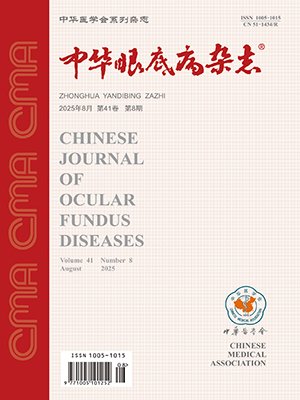Objective To compare difference of the cross-sectional pathological imaging and quantitative measurement of central serous chorioretinopathy (CSC) between time- and fourier-domain optical coherence tomography (OCT). Methods Consecutive 26 patients (26 eyes) with unilaterial CSC were subsumed. Bilateral eyes of all the patients underwent time- and fourier-domain OCT. Horizontal and vertical line scanning and radial six-line scanning protocols were used for timedomain OCT examination; horizontal and vertical high resolution five-line scanning and macular cube scanning protocols were used for fourier-domain OCT examination. The characteristics of OCT images, retinal segmentation and the quantitative measurement were compared between these two methods. Results Fourier-domain OCT could yield the three-dimensional images of surface of inner limiting membrane (ILM) and RPE. The band of external limiting membrane (ELM) of normal subjects and CSC patients, and the inner segment and outer segment (IS/OS) of normal subjects could be clearly shown by fourier-domain OCT. However, the band of IS/OS disappeared in 65.4% of the CSC patients. The outer boundary of retina was defined in front of the retinal pigmental epithelia (RPE) by fourier-domain OCT. The foveal thickness of normal subjects and CSC patients was (180.50 plusmn;12.69) and (158.41 plusmn;34.20) mu;m, respevtively. The height of detachment of neural epithelial layer was (245.84 plusmn;154.61) mu;m measured by fourier-domain OCT. The band of IS/OS of normal subjects could be clearly shown by time-domain OCT. However, the band of IS/OS disappeared in 73.4% of the CSC patients, which showed no difference with fourier-domain OCT (Z=-0.108, P=0.914). The outer boundary of retina was defined in front of the IS/OS band by OCT. The foveal thickness of normal subjects was (141.16 plusmn;12.75) mu;m, which was thinner than that measured by fourier-domain OCT (t=20.671,P=0.000). The foveal thickness and the height of detachment of neural epithelial layer was (146.40 plusmn;36.28) mu;m and (240.32 plusmn;156.82) mu;m measured by time-domain OCT, respectively, which showed no significant difference with which measured by fourier-domain OCT (t value was from 0.026 to 1.517, P value was from 0.144 to 0.980). Conclusions Fourier-domain OCT yields better visualization of intraretinal layers and more accurate definition of outer boundary of retina than time-domain OCT. Thus the measurements by fourier-domain OCT were more accurate. Moreover, three-dimensional images of CSC shown by fourier-domain OCT enable the comprehensive observation of pathological morphology and location.
Citation: 黄晶晶,刘杏,钟毅敏,毛真,郑小平. Comparison between time- and Fourier-domain optical coherence tomography in the patients with central serous chorioretinopathy. Chinese Journal of Ocular Fundus Diseases, 2009, 25(3): 164-168. doi: Copy
Copyright © the editorial department of Chinese Journal of Ocular Fundus Diseases of West China Medical Publisher. All rights reserved




